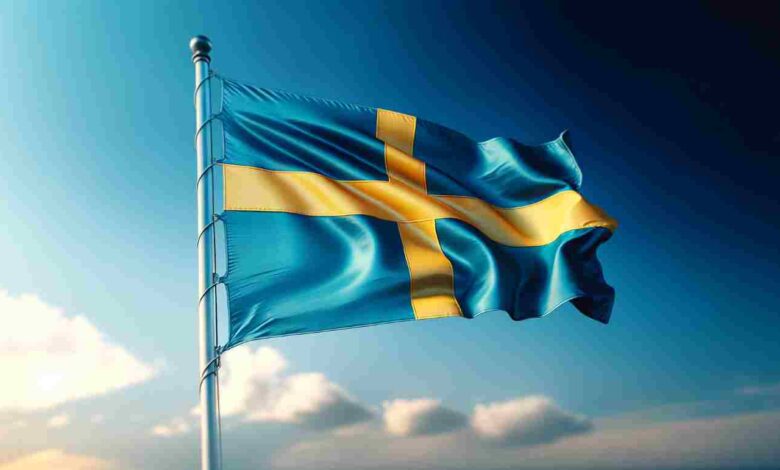The Big History of the Swedish Flag

The Swedish flag, with its distinctive blue background and yellow cross, holds deep historical and cultural significance for the people of Sweden. The story of the Swedish flag spans centuries, reflecting not only the country’s national identity but also its journey through medieval times, periods of union with neighboring countries, and its emergence as a modern state. Let’s take a closer look at the fascinating history behind this iconic symbol.
The Origins of the Swedish Flag
Legend has it that the Swedish flag comes from as far back as the 12th century. Legend has it that King Eric IX saw a golden cross emblazoned in the sky when he turned into the fight in Finland. He took it as a sign of godly appearance, and thus chose it to be the symbol image for Sweden. Although this remains in the realm of folklore, we’ve got more concrete evidence regarding when the flag first saw use from records dating back to the sixteenth century. King John III goes a little further in 1569 as documents show that the flag with the yellow cross on a blue field was already in use at this point.
The Swedish flag is designed in the image of a Nordic cross that many of the Scandinavian countries like Denmark and Norway share with Sweden. A design inspired by a shared Christian heritage among the nations of the region. The cross, as it also appears in the Swedish version of the flag, is sort of moved over to the left slightly which causes this and many people regard that as a sign that it’s acceptable.
Symbolism and Meaning
he colours of the Swedish flag, blue and yellow, have been taken from the national coat of arms which dates back to the times of Gustav Vasa in the early 16th century. The enduring blue conveys loyalty, truth, and justice; the golden yellow represents generosity and the wealth of our land.
These colours have been linked to Swedish royalty since the late 19th century and feature in the country’s Three Crowns emblem, which is a national emblem tied to Sweden and representing the nation’s three historic lands: Svealand, Götaland, and Norrland. Like in other Scandinavian countries, the cross on the flag was first and foremost an expression of Christianity. But later, it symbolised not only religious belief but also national solidarity, the same history, and a love for a Viking/living God.
Historical Milestones
The more comprehensive regulation of the Swedish flag color came with the Swedish Flag Act in 1663, which declared: Norway was, however, in a personal union with Sweden at this time, and the canton of the flag (in the top left) featured an emblem to show unity between the two nations.
This pattern held until 1905, the year in which the union between Sweden and Norway was disbanded when they officially adopted a new version of their own flag still in use today (since 1906). The naval ensign of Sweden is in squared or swallowtail triple-tailed form. This flag was first used only by the king, but it has later been hoisted by the Royal Swedish Navy, with the royal standard flying on a Swedish warship.
Modern Use of the Flag
This has nowadays become a very significant part of Swedish heritage, with the flag being seen on all special national days such as Midsummer and Sweden’s National Day, celebrated on June 6th each year. During these times, flags wave throughout the streets of Sweden, creating a festive fervor that sparks strong nationalist emotions. In Sweden, the flag is a feature of everyday life and can be seen everywhere, from homes and government buildings to businesses.
It is also widely used in Swedish branding—both IKEA and Volvo heavily incorporate the colors of the flag in their corporate logos and product branding. The flag serves to drive innovation, quality, and social sustainability for Sweden’s largest institutions.
The Swedish Flag Today: A Global Symbol
Not only is the Swedish flag a sign of its long history and cultural identity, it also shows Sweden’s place as an influential actor in world affairs today. On display at international sporting events and diplomatic occasions, the flag symbolizes Sweden’s engagement in world peace, human rights, justice, and conservation efforts. A song that unites us across borders and creates a sense of belonging among Swedish citizens wherever they are in the world.
Recently, the flag has also been adopted as a symbol of international solidarity. When the world has faced global crises or natural disasters, national pride in the form of a flag flown from roofs and windowsills has come out with people as an expression of sympathy for those in need, reinforcing Sweden’s firm attachment to its role on the world stage.
The Role of the Swedish Government and Society
The Swedish flag, with its blue and yellow cross, is deeply tied not only to the country’s history but also to its government and society. Sweden is known for its democratic principles, a well-functioning welfare system, and a commitment to human rights and social justice. The Swedish flag serves as a unifying symbol for these ideals and is widely associated with the values that shape the country today.
Sweden’s Government System
It is a constitutional monarchy and parliamentary democracy. The country is a diarchy, with one of the two monarchs being the eldest son of an elderly King Carl XVI Gustaf. The Prime Minister and the Swedish Parliament (Riksdag), to whom the cabinet report is responsible, have actual governing power. A single-chamber Parliament, the Riksdag consists of 349 members that serve for four-year terms.
The Prime Minister is the head of government in Sweden, leading the government (regeringen) and holding actual executive power. That which the Swedish flag projects in a bold manner both during governmental ceremonies and sessions of its parliament, stands as further reinforcement that this is a sovereign state with democratic governance.
The Swedish Welfare State
When it comes to Sweden, many recognize the “Swedish Model” for its broad welfare system and social framework. This system offers citizens a range of social benefits, including free education, healthcare, generous parental leave, and pensions. Funded by some of the highest taxes in Europe, this welfare state is viewed as a crucial part of Sweden’s commitment to equality and social justice.
The Swedish system redistributes wealth from the wealthiest individuals and businesses to ensure a fair quality of life for all. The Swedish flag, prominently displayed on government buildings, symbolizes this state-sponsored commitment to welfare and equality, reflecting a shared responsibility between government and society to care for all citizens and foster social unity.
Social Equality and Human Rights
Swedish society is recognized for its emphasis on equality and human rights. Gender equality is a core value in Sweden, with policies ensuring that both women and men have equal rights in both the workplace and at home. The Swedish government strongly supports women, with nearly half of its representation held by women, promoting feminism as a key principle to combat discrimination.
Additionally, Sweden has been a frontrunner in advocating for LGBTQ+ rights, pushing for equal treatment regardless of sexual orientation, gender identity, or background. The Swedish flag symbolizes these inclusive ideals, standing for fairness and justice in all aspects of life.
Sweden’s Global Role
Sweden, on the global scene, is synonymous with peace speaking, diplomacy, and human rights. It is an active partner in organizations such as the United Nations and the EU, taking pro-environment positions globally that stem from its clean tech economy. In international appearances, Sweden has always raised the flag at sporting events as a tribute to peace and humanitarian efforts.
Sweden is also one of the first to provide support and assistance in global crisis situations, both during natural disasters and conflict alike. In these cases, the blue and yellow cross of Sweden’s flag also becomes a symbol for hope and solidarity — and is used to illustrate the country’s humanitarism and natural desire to help those in need.
Languages in Sweden
Sweden is a linguistically rich country, with Swedish as the official and dominant language. However, the country’s approach to languages is highly inclusive, reflecting its values of equality and diversity. While Swedish is the primary language spoken by the vast majority, several minority languages and English are also widely used in daily life, education, and media.
Swedish: The Official Language
The Swedish (Svenska) is an official language of Sweden and the national language since 2009. It is a North Germanic language and shares strong linguistic premises with Norwegian and Danish. Old Norse influenced its early development, with the language continuing to evolve over centuries.
Swedish education, government, and media are exclusively in Swedish. It is also very important for national identity, and its use is closely linked to Swedish culture, literature, and heritage. In Sweden, where the rights of freedom are widely advertised on public institutions such as schools and universities by carrying Swedish flags, it symbolizes not only national sovereignty but also one language: Swedish.
Minority Languages in Sweden
Swedish is the official language of Sweden, but this country also has five minority languages that it formally recognizes: Finnish, Meänkieli, Sami, Romani, and Yiddish. These languages have minority language status in accordance with the Swedish Minority Language Act, except for Romani for which a separate law exists.
Finnish and Meänkieli
Finnish is the second most spoken language in Sweden because of its old ties with Finland. Also, the Tornedal region in Southeast Finland has been granted the status of a minority language with the Meänkieli variant of Finnish. Such languages are an integral part of Sweden’s cultural heritage, and the state has supported their preservation through, for example, bilingual education and various cultural initiatives.
Sami
Sami is spoken in the northern parts of Sweden, Norway, Finland, and Russia by the indigenous Sami people. Sweden is home to about 6,000 Sami-language speakers. The Swedish government actively recognizes Sami as a language, ensuring it does not fall into decline. With eight recognized dialects and one official written version, Sami-language education and media are supported.
Romani and Yiddish
Romani is spoken by the Roma people in Sweden, while Yiddish is used by some members of the Jewish community. Both languages hold significant cultural importance, and the government safeguards their preservation. Speakers of Romani and Yiddish can access public services and education in their languages.
English in Sweden
While Swedish is the predominant language, English plays an important part in Swedish society. Because the Swedes believe in global engagement and international education, all children start learning English early on in school. English is a mandatory second language taught in school, and many Swedes speak it at a near-native level while watching every US movie everywhere with subtitles and from listening to British pop songs.
In fact, Sweden ranks among the top non-native English-speaking countries in terms of proficiency. English is frequently used in universities, particularly in postgraduate education, where many courses are taught in English. This makes Sweden an attractive destination for international students and professionals.




